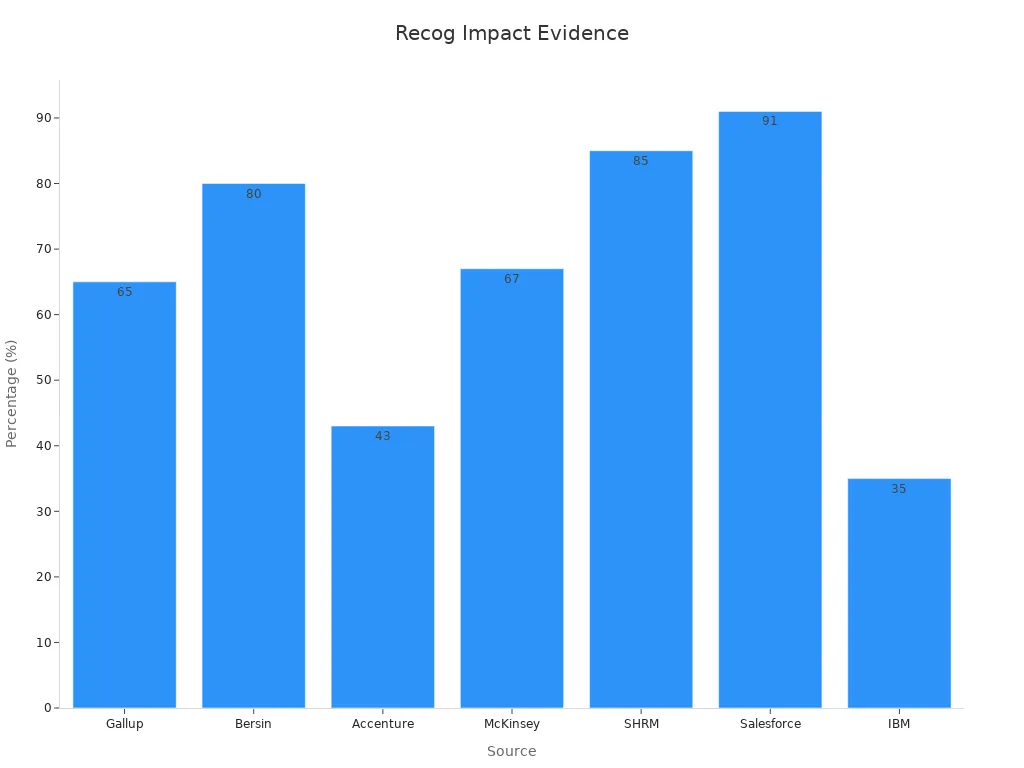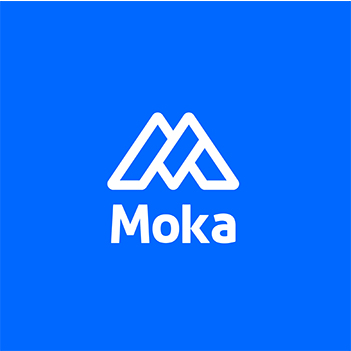How to Build a Culture of Recognition in 2025

Creating a workplace where recognition thrives isn’t just a nice-to-have—it’s a game-changer. Did you know that 77.9% of employees say they’d be more productive if recognized more often? It’s not just about productivity, though. Employees who feel valued are seven times more likely to stay with their company for at least another year. Building a Culture of Recognition in the Digital Age means embracing practices that make everyone feel appreciated, whether they’re in the office or working remotely. When you prioritize recognition, you’re not just boosting morale—you’re building loyalty and teamwork that lasts.
Key Takeaways
Saying 'thank you' makes workers feel good and work harder.
Using online tools helps quickly recognize success and show gratitude.
Regular praise keeps workers from leaving. Feeling valued makes them stay.
Fair recognition honors everyone's efforts, so all feel important.
Teach managers to give praise. Their actions inspire others to do the same.
Building a Culture of Recognition in the Digital Age

Defining Recognition in the Modern Workplace
Recognition in today’s workplace is all about making employees feel valued. It’s not just about saying “good job” but about showing that their contributions matter. When you recognize someone, you’re telling them their work aligns with the company’s goals and makes a difference. This isn’t just a feel-good gesture—it’s a strategic move. Employees who feel seen and appreciated are more engaged and motivated. They’re also more likely to stick around, which saves your company time and money.
The Evolution of Recognition Practices
Recognition has come a long way. In the past, it was often infrequent and formal, like an annual award ceremony. Now, it’s immediate, personalized, and inclusive. For example, companies like Salesforce use peer-to-peer systems to encourage employees to recognize each other. This approach has boosted engagement and collaboration. Google’s “Thanks” program is another great example. It increased employee satisfaction by 29% and reduced turnover by 12%. These modern methods show that recognition isn’t just a nice-to-have—it’s a must-have for any thriving workplace.
Traditional Methods | Modern Methods |
|---|---|
Infrequent | Immediate |
Lacks personalization | Personalized |
Fails to meet diverse needs | Meets diverse needs |
Inability to provide timely feedback | Provides timely feedback |
The Role of Technology in Recognition
Technology has made it easier than ever to build a culture of recognition in the digital age. Tools like Bonusly and Kudos allow you to recognize achievements in real time, no matter where your team is located. These platforms make recognition more accessible and engaging. At Innovatech, for instance, using digital tools reduced turnover from 20% to 8% in just one year. When you use technology to recognize your team, you’re not just boosting morale—you’re creating a workplace where everyone feels valued and connected.
Benefits of a Recognition Culture
Boosting Employee Morale and Engagement
When employees feel appreciated, their morale soars. Recognition programs are a powerful way to show your team that their efforts matter. Did you know that 67% of workers rate praise as their top motivator? It’s true! A simple “thank you” or acknowledgment of a job well done can make a huge difference. Companies with strong recognition programs report a 58% increase in employee engagement. That’s not just a number—it’s a sign of happier, more motivated teams.
Recognition also helps reduce turnover. Lack of acknowledgment leads to 43% of voluntary departures. By creating a culture where recognition is frequent and meaningful, you can keep your best talent and save on hiring costs.
Here’s a quick look at the benefits organizations experience:
Benefit | Statistic |
|---|---|
Increase in employee engagement | 58% |
Lower turnover | |
Higher productivity | 18% |
Strengthening Alignment with Company Values
Recognition isn’t just about boosting morale—it’s also a tool for reinforcing your company’s values. When you reward employees for behaviors that align with your mission, you’re showing everyone what matters most. For example, structured recognition programs help employees understand how their actions contribute to the bigger picture. This creates a sense of purpose and inspires others to follow suit.
Salesforce’s “Ohana” program is a great example. It not only boosted morale but also contributed to an impressive 25% annual revenue growth. That’s the power of aligning recognition with values. Employees who see their efforts tied to the company’s mission are more likely to internalize those values and act as ambassadors for your brand.
Enhancing Collaboration and Teamwork
Recognition doesn’t just impact individuals—it strengthens teams. When you acknowledge contributions, you’re fostering a culture of mutual respect and collaboration. In hybrid workplaces, recognition bridges the gap between remote and in-office employees. It creates a sense of unity, no matter where your team is located.
In fact, 81.9% of employees believe that recognition enhances engagement, which directly improves teamwork. Acknowledging team efforts reinforces a shared sense of purpose and motivates everyone to work together toward common goals. Recognition isn’t just a pat on the back—it’s the glue that holds your team together.

Reducing Turnover and Improving Retention
Employee turnover can be a costly challenge, but recognition programs can make a huge difference. When you show your team that their efforts matter, they’re more likely to stay. Think about it—would you leave a workplace where you feel valued and appreciated? Probably not. Recognition creates a sense of belonging, which is key to keeping your best talent.
Companies that prioritize recognition see real results. Here are some examples:
Innovatech reduced its turnover rate from 20% to 8% in just one year by implementing a recognition program.
Google’s recognition efforts led to a 12% drop in turnover and a 29% boost in employee satisfaction.
SHRM found that organizations with strong recognition practices retain 31% more employees.
These numbers aren’t just statistics—they’re proof that recognition works. When employees feel seen, they’re more engaged and less likely to look for opportunities elsewhere.
Recognition also saves money. High turnover means spending more on recruitment, training, and onboarding. By keeping your team happy, you avoid those extra costs. Plus, a stable workforce leads to better collaboration and stronger relationships.
Peer recognition plays a big role too. When coworkers acknowledge each other’s contributions, it builds a supportive environment. According to the Incentive Research Foundation, 70% of employees link job satisfaction to peer recognition.
If you want to reduce turnover, start by making recognition a priority. Celebrate achievements, big or small. Show your team that their hard work doesn’t go unnoticed. It’s a simple step that can lead to long-term success.
Overcoming Challenges in Recognition
Addressing Budget Constraints
You don’t need a massive budget to create meaningful recognition programs. Small gestures can have a big impact. A simple “thank you” or a shoutout during a team meeting costs nothing but goes a long way in making employees feel valued. If you have some budget, consider low-cost options like digital badges, certificates, or gift cards. These small tokens of appreciation can make employees feel special without breaking the bank.
Time is another hidden cost. Many employees say they don’t recognize others because they’re too busy. In fact, 31% of employees cite “not enough time” as a barrier to recognition, while 20% say there’s no clear process for it. Take a look at the table below to see the common barriers employees face:
Barrier Type | Percentage of Employees Affected |
|---|---|
Not enough time | 31% |
No tool or clear process | 20% |
Not something they think about | 18% |
Not sure how to do it | 15% |
Not encouraged | 8% |
Not comfortable | 8% |
By addressing these barriers, you can make recognition easier and more accessible for everyone.

Ensuring Inclusivity in Recognition Programs
Recognition should make everyone feel seen and valued. To achieve this, you need to ensure your programs are inclusive. Recognize employees for their unique contributions, not just for hitting traditional performance metrics. For example, celebrate creativity, teamwork, or problem-solving. This approach fosters a culture of belonging.
Here are some tips to make your recognition programs more inclusive:
Recognize and reward employees frequently to show appreciation for their uniqueness.
Use HR tools to measure diversity and inclusion progress.
Gather employee feedback through surveys to understand their perspectives on inclusivity.
Incorporate diversity into hiring practices by training interviewers on unconscious bias.
Did you know that 88% of employers consider diversity and inclusion initiatives essential to their success? By aligning recognition with these initiatives, you create a workplace where everyone feels valued.
Adopting Digital Tools and Platforms
Digital tools make recognition easier, faster, and more impactful. Platforms like Bonusly and Kudos allow you to recognize achievements in real time, no matter where your team is located. This instant acknowledgment boosts morale and fosters a culture of appreciation. For global teams, digital reward marketplaces offer region-specific rewards, like subscriptions or charitable giving, making recognition more meaningful.
These tools don’t just streamline recognition—they also align with your company’s mission. By using them, you create meaningful connections that empower employees and build a positive workplace culture. When recognition becomes part of your daily workflow, it’s no longer an afterthought—it’s a core part of your success.
Maintaining Consistency Across Remote Teams
Keeping recognition consistent across remote teams can be tricky, but it’s absolutely worth the effort. When employees work from different locations, they often miss out on the casual acknowledgment that happens in an office setting. This can leave them feeling disconnected or undervalued. You can prevent this by making recognition a regular part of your team’s routine.
Here’s how you can make it happen:
Recognize frequently: Remote employees may feel isolated, so regular recognition helps them stay connected to the team. A quick shoutout during a virtual meeting or a message in your team chat can go a long way.
Track recognition: Use tools to monitor how often employees are acknowledged. This ensures no one gets overlooked and helps you spot patterns in engagement.
Successful leaders often organize monthly sessions to celebrate achievements. These can be virtual events where you highlight individual and team contributions. It’s not just about saying “good job”—it’s about showing your team that their efforts matter, no matter where they’re working.
Tip: Use digital platforms to make recognition seamless. Tools like Bonusly let you give kudos in real time, ensuring everyone feels appreciated, even across time zones.
Consistency also means aligning recognition with your company’s values. When you celebrate behaviors that reflect your mission, you reinforce what’s important. This creates a sense of purpose and keeps everyone on the same page, whether they’re in the office or working remotely.
By prioritizing recognition, you’re not just boosting morale—you’re building a stronger, more connected team. Remote work doesn’t have to mean remote feelings. With consistent recognition, you can bridge the gap and create a culture where everyone feels valued.
Strategies for Building a Recognition Culture
Leveraging Digital Recognition Platforms
Digital recognition platforms are game-changers when it comes to making employees feel valued. These tools allow you to celebrate achievements instantly, no matter where your team is located. Platforms like Bonusly and Kudos make it easy to send shoutouts, award points, or even give small rewards. This kind of instant acknowledgment boosts morale and keeps everyone connected.
Participation rates are a great way to measure the success of these platforms. High participation shows that your team is engaged and excited about recognition. Plus, when employees feel appreciated, they’re more likely to stay. Lower turnover and higher engagement are just some of the benefits you’ll see. And let’s not forget the impact on business outcomes—recognition programs often lead to better revenue and customer satisfaction.
If you’re serious about building a culture of recognition in the digital age, digital platforms are a must-have. They make recognition seamless, meaningful, and accessible for everyone.
Empowering Managers to Lead Recognition Efforts
Managers play a huge role in creating a culture of recognition. When they take the lead, it sets the tone for the entire team. Regular recognition from managers can make employees feel seen and valued, which boosts engagement and productivity. Did you know that employees recognized weekly are three times more likely to feel engaged than those who aren’t?
To empower managers, provide them with the tools and training they need. Teach them how to give meaningful feedback and encourage them to recognize both big wins and small efforts. Salesforce’s “Ohana” program is a great example. It led to a 91% employee engagement rate and a 23% increase in collaboration. When managers lead by example, it creates a ripple effect that inspires the whole team.
Incorporating Gamification into Recognition
Gamification adds a fun twist to recognition. By introducing elements like points, badges, and leaderboards, you can make recognition more engaging. Employees love a little friendly competition, and gamification taps into that. Organizations that use gamification see a 48% increase in productivity and a 25% higher retention rate.
You can also use gamification to celebrate small wins. For example, award points for meeting deadlines or helping a teammate. Over time, these small moments add up, keeping motivation high. Gamification doesn’t just make recognition fun—it makes it consistent and rewarding.
By combining digital tools, strong leadership, and gamification, you can create a recognition culture that’s both effective and enjoyable.
Encouraging Peer-to-Peer Recognition
Peer-to-peer recognition is one of the most powerful ways to build a culture of appreciation. When coworkers acknowledge each other’s efforts, it creates a ripple effect of positivity. It’s not just about boosting morale—it’s about fostering trust and connection. Imagine how much stronger your team could be if everyone felt valued by their peers.
Research shows that employees who receive recognition at least once a month are twice as likely to feel connected to their coworkers. This sense of belonging builds a culture of trust and collaboration. When employees feel appreciated by their peers, they’re more likely to go the extra mile and support one another.
Here’s how you can encourage peer-to-peer recognition in your workplace:
Create a platform for shoutouts: Use tools like Slack or Microsoft Teams to set up a dedicated channel for recognition.
Make it easy: Provide templates or prompts to help employees express their appreciation.
Celebrate publicly: Highlight peer recognition during team meetings or newsletters.
Tip: Peer recognition doesn’t have to be formal. A quick “thank you” or a simple emoji can make someone’s day. 🎉
When you empower your team to recognize each other, you’re not just building a culture of appreciation—you’re creating a workplace where everyone feels seen and valued.
Integrating Recognition into Daily Workflows
Recognition shouldn’t feel like an extra task. It works best when it’s woven into your daily routines. By making it a natural part of your workflow, you ensure it happens consistently and meaningfully.
Start by identifying moments in your team’s day where recognition can fit seamlessly. For example:
Kick off meetings with kudos: Begin team meetings by acknowledging recent achievements.
Use project milestones: Celebrate small wins as your team progresses toward larger goals.
Incorporate recognition into tools: Platforms like Asana or Trello can include features for celebrating completed tasks.
Note: Recognition doesn’t have to be time-consuming. A quick comment or a digital badge can go a long way.
When recognition becomes part of your daily workflow, it feels authentic and effortless. It’s not just about saying “good job”—it’s about creating a culture where appreciation is second nature.
Future Trends in Recognition

AI-Driven Personalization in Recognition
Artificial intelligence (AI) is transforming how recognition works. Imagine a system that knows exactly how you like to be appreciated—whether it’s a public shoutout, a private message, or a small reward. AI makes this possible by analyzing data about your preferences and performance. It helps organizations tailor recognition efforts to each employee, making them feel truly valued.
Here’s how AI is making recognition more personal:
It analyzes large data sets to understand individual preferences.
It adjusts recognition methods based on your performance and feedback.
It creates personalized experiences that boost engagement and motivation.
Studies show that personalized recognition improves engagement and self-confidence. Employees feel more connected when recognition aligns with their unique needs. AI doesn’t just make recognition smarter—it makes it more meaningful.
The Role of Emerging Technologies like AR/VR
Augmented reality (AR) and virtual reality (VR) are no longer just for gaming. These technologies are stepping into the workplace, offering exciting ways to recognize employees. Imagine putting on a VR headset and walking through a virtual hall of fame featuring your achievements. Or using AR to see a 3D trophy pop up on your screen when you hit a milestone. These experiences make recognition more interactive and memorable.
Future recognition strategies will also use predictive analytics and machine learning. These tools help organizations understand what motivates employees and predict the best ways to celebrate their successes. By combining AR, VR, and advanced analytics, companies can create recognition programs that feel futuristic yet personal.
Real-Time Feedback Systems
Real-time feedback is changing the game for employee recognition. Instead of waiting for annual reviews, you can now get instant acknowledgment for your hard work. This keeps you motivated and helps you improve continuously. Companies like Google and Adobe are already leading the way. Google uses a system called OKRs (Objectives and Key Results) to provide regular feedback, while Adobe’s “Check-ins” focus on ongoing conversations between managers and employees. Both approaches have boosted employee satisfaction and performance.
Real-time feedback systems make recognition faster and more effective. They ensure that your efforts are noticed right away, creating a culture where appreciation is constant. When recognition happens in the moment, it feels more genuine and impactful.
Tip: Real-time feedback doesn’t just benefit employees—it helps managers build stronger, more connected teams.
By embracing these trends, organizations can create recognition programs that are not only innovative but also deeply meaningful. The future of recognition is here, and it’s all about making you feel valued in ways that matter most.
Recognition as a Core Component of Employee Experience
Recognition isn’t just a perk—it’s the heartbeat of a great employee experience. When you feel valued at work, everything changes. You’re more motivated, more engaged, and more likely to stick around. That’s why recognition needs to be more than an occasional pat on the back. It should be woven into the fabric of your company’s culture.
Think about it. How often do you hear “great job” or “thank you” at work? If it’s rare, it can feel like your efforts go unnoticed. But when recognition happens regularly, it creates a ripple effect. You feel appreciated, your confidence grows, and you’re inspired to do even better. It’s not just about boosting morale—it’s about creating a workplace where everyone thrives.
The 2023 Global Culture Report by the O.C. Tanner Institute emphasizes that recognition needs to be embedded into the culture of an organization, as a natural response to great work. Recognition needs to be frequent, timely, and specific – something that moves from being a once or twice per year transaction to a purposeful and meaningful employee experience that is given, observed, and received throughout an employee’s journey as an everyday part of operational culture.
Recognition also strengthens the connection between employees and their organizations. When you’re recognized for your contributions, you see how your work aligns with the company’s goals. This sense of purpose keeps you engaged and loyal. Lori Winters, VP of Total Rewards at Southwest Airlines, puts it perfectly:
“When you take a journey view of recognition and appreciation, you start to think about it differently, and you start to see there are many opportunities to have recognition touchpoints with employees.”
By making recognition a core part of your workplace, you’re not just saying “thank you.” You’re building a culture where everyone feels valued, supported, and ready to succeed.
Building a culture of recognition in 2025 isn’t just a nice idea—it’s essential. When you prioritize recognition, you create a workplace where employees feel valued, engaged, and motivated. Did you know that employees recognized weekly are three times more likely to stay engaged? Or that 90% of employees work harder when they feel appreciated?
Statistic | Insight |
|---|---|
69% | Employees would work harder if recognized consistently. |
74% | Recognized employees feel their work is useful and valuable. |
Recognition isn’t just about saying “thank you.” It’s about fostering loyalty, boosting productivity, and building a team that thrives in a digital-first world.

By embracing technology and inclusivity, you can create meaningful recognition practices that drive long-term success.
FAQ
1. Why is recognition important in 2025?
Recognition boosts morale, engagement, and loyalty. Employees who feel valued work harder and stay longer. In 2025, with remote work and digital tools, recognition helps bridge gaps, creating a connected and motivated team. It’s not just a perk—it’s essential for success.
2. How can small businesses implement recognition programs?
Small businesses can start with simple gestures like verbal praise or handwritten notes. Use affordable tools like digital badges or gift cards. Focus on frequent, meaningful acknowledgment. Even a quick “thank you” during meetings can make a big difference without straining your budget.
Tip: Consistency matters more than cost. Recognize efforts regularly!
3. What’s the best way to recognize remote employees?
Use digital platforms like Bonusly or Slack to give shoutouts in real time. Celebrate milestones during virtual meetings. Send personalized messages or small rewards. Recognition keeps remote employees connected and valued, even from afar.
4. Can gamification really improve recognition?
Absolutely! Gamification makes recognition fun and engaging. Use points, badges, or leaderboards to celebrate achievements. Employees enjoy friendly competition, which boosts motivation and teamwork. It’s a creative way to keep recognition consistent and exciting.
5. How do I ensure recognition is inclusive?
Recognize diverse contributions, not just traditional metrics. Celebrate creativity, teamwork, and problem-solving. Use employee feedback to improve inclusivity. Inclusive recognition ensures everyone feels valued, fostering a sense of belonging.
Note: Inclusivity strengthens your culture and builds trust across teams.
See Also
Celebrating Human Resources Innovation at the 2024 Sirius Awards
Achieving Recruitment Success Through AI: MokaHR's Strategy
Empowering Your Business Growth with Effective ATS Recruitment
Revolutionizing Hiring Practices: The Advantages of MokaHR
Maximizing Talent Potential with MokaHR's Online Management System
From recruiting candidates to onboarding new team members, MokaHR gives your company everything you need to be great at hiring.
Subscribe for more information

